|
|
|
|
|
|
|
|
|
|
|
|
|
|
|
|
|
|
|
The Legend of
the Gulls
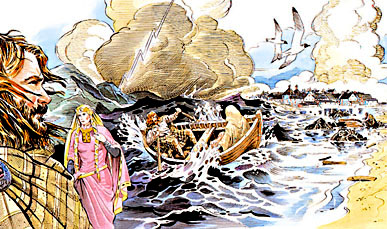
Legend has it that a pair
of gulls fly ceaselessly above Lochindaal, on the shores of which lies the
Bowmore Distillery.
When the Scots spread from
their Celtic homeland to create the Kingdom of Dalriada–in–Alban, the
Pictish and Brythonic tribes who already occupied the lands resisted
fiercely. Much blood was spilt as war raged between them and the incomers.
Legend has it that the
daughter of a Pictish King fell in love with a captured Scottish warrior
and helped him escape. Together they fled westwards to the Isles. As they
rowed towards the young warrior’s home on the shores of Lochindaal, the
sea loch which bites into the heart of Islay, a terrible storm lashed
their boat, sending it crashing against the rocks.
The young Scot’s clansmen
found only splintered wreckage of the boat and no trace of the lovers –
but a pair of white gulls soared and swooped together across the Loch,
settling neither on the western nor the eastern shore, as if torn between
the two.
The legend endures, and
today, before a storm, the Bowmore Distillery echoes to the haunting cry
of a pair of gulls.
 |
|
|
|
The Legend of
the Devil
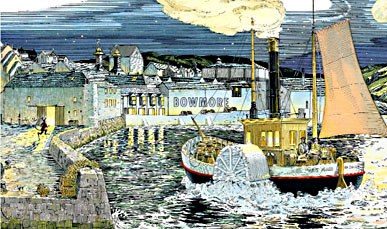
Legend has it that in
1837, on a clear winter’s evening, the devil visited the church in
Bowmore.
The church was round in
shape, purposely built, in preparation for such a visit as there were no
corners in which the devil could hide. The local congregation chased the
devil from the church. He fled through the village, eventually finding a
hiding place in Bowmore distillery. The villagers raced through the
distillery, in search of the devil.
That night the
Warehousemen were filling the golden Bowmore whisky into casks and loading
them aboard The Maid of Islay, the tiny paddle steamship used for
transporting Bowmore whisky to the mainland. All the distillery doors and
gates were slammed shut and locked to prevent the devil’s escape. The
distillery was searched from the maltbarns to the mash house, but the
devil was nowhere to be found. The Maid of Islay, loaded with the last
cask of Bowmore, gave a loud blast of her horn and paddled off across the
calm Loch Indaal into the clear dark night.
The devil was never found
that night, but, as legend goes, escaped in a cask of Bowmore destined for
the mainland. Whether The Maid of Islay ever reached the mainland is not
known, but on certain still winter nights, the sound of the sea lapping
against the distillery wall is akin to the faint paddling of a small
steamship in the distance.
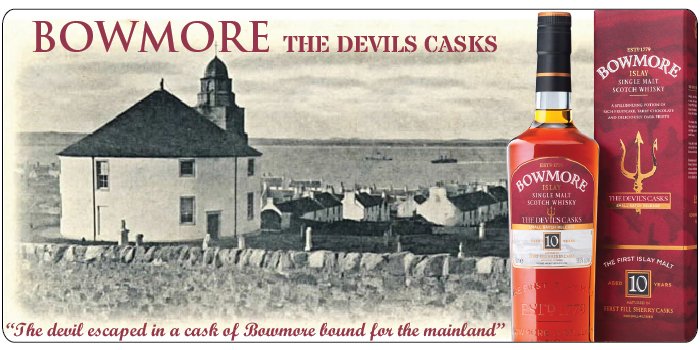
|
|
|
|
The Legend of the
Phantom Horseman

Legend has it that Lachlan
Bàn, an Islay crofter, was returning home one stormy night when, through
the darkness, he saw a ghostly sight. The silhouette of a headless
horseman galloping away from his house. Lachlan turned pale.
On entering the house,
Lachlan felt an eerie coldness. The fire he had left blazing, only an hour
before, had gone out. In the middle of the stone floor was a circular damp
stain, and on the table stood an opened bottle of Bowmore Malt whisky with
a large dram missing. What kind of creature had visited?
Accepting gifts, even
Bowmore whisky, from such a fearful intruder could only lead to misfortune
thought Lachlan. So he threw the bottle out into the wet night, bolting
the door behind him, and spent a troubled night listening to the howls of
the wind and the rattling of the windows, fearful for his life. The next
night at the local Inn Lachlan related the frightening tale to a hushed
group of locals.
The following week
Lachlan’s brother called to him. “Lachlan, I passed last Friday night
during that dreadful storm. The wind had forced your door open and blown
out the fire, I brought a bottle of Bowmore to share with you, but I
couldn’t wait long, so I took a quick dram and rode for home with my cloak
pulled tight over my head to keep out the rain.” Too embarrassed to tell,
Lachlan never related the true story to the villagers.
To this day, no true
Ileach offers an opened bottle of whisky to guests. A fresh bottle is
always opened and the cork thrown into the fire so that the guest can be
sure that the headless horseman has not returned....Or is it just an
excuse for another dram of Bowmore?
|
|
|
|
|
|
|
|
|
|
|
|
|
|
|
|
|
|
|
|
|
The Legend of
the Princess Giant

The King of Giants was
gravely warning his daughter, Iula. “You must never go over the sea, it is
dangerous, even for a giant.” Iula nodded in agreement and went to bed.
But the beautiful giantess
did not sleep and as the full moon rose, her spirit of adventure lifted
too. She crept down to the beach, where she gathered large rocks to use as
stepping stones. Then Iula gently placed them, one by one, in front of her
into the sea.
She went on, all through
the night until, exhausted, she reached the shores of a dark island. But,
in the soft sands of the shore, her footsteps sank and the sea washed over
her, claiming her for its own.
The island she discovered
took her name and, to this day, Islay is named in her honour.

|
|
|
|
The Legend of the
Laird and the Angel

Long ago a cruel, but
god-fearing, Laird journeyed in search of a bride. On the shores of Loch
Indaal he met a starving fisherman and his bride to be. The Laird
instantly fell in love with the beautiful girl and offered to buy her hand
in marriage. The fisherman knew that he could never give his bride wealth,
like the Laird, so heartbroken he reluctantly gave his bride away.
Years passed but no love
blossomed between them. Each day she saw her true love pass by on his way
back from the Loch and each night she wept into her pillow and yearned to
be with him.
The cruel Laird overheard
her tears and made her an offer, “If you can steal my soul by the morn’ I
shall turn to stone and you may go free. But if you fail you will stay and
love me as you love him”. She agreed.
As night fell the girl
thought long and hard of how to steal a man’s soul. Just then she saw the
fisherman pass by and, in a flash of inspiration, called down to him: “My
love, bring me your catch at midnight and we may be together forever”
Puzzled, the fisherman agreed.
Midnight came and he
brought his catch to her. All night the girl gutted the fish and sewed
together the silvery scales into a beautiful dress. Just before dawn the
Laird awoke as the day’s first rays of sun shone brightly onto the girl’s
dress. Believing her to be an angel from heaven, the god-fearing Laird
fell to his knees and pledged his soul to her. Upon revealing her true
self, he turned to stone and free she ran off to be with her true love
once more.
|
|
|
|
The Legend of
the Sea Maiden

The old fisherman looked
forlornly at his dripping, empty net. Suddenly, a sea-maiden rose to the
surface of the sea.
“I will give you good fishing in return for your first born son,” said
she.
Desperately hungry, the
fisherman eagerly consented. Soon a son was born to him, but he could not
give up the boy. A soothsayer said that to break the promise, the boy
would have to find the ghostly white deer that so many feared, slay it,
and break the golden egg hidden inside.
Years later, the son – now
a young man – went on a quest for the deer. The sea-maiden was angry, but
before she could push the old fisherman into the sea, the son slew the
deer and smashed the egg into a million pieces. The promise was broken and
the sea-maiden banished to the deep forever.
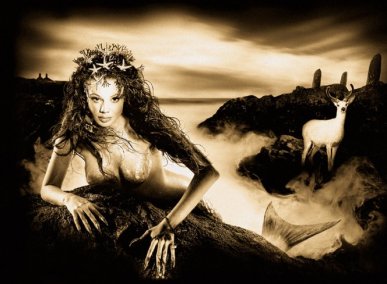
|
|
|
|
|
|
|
|
|
|
|
|
|
|
|
|
|
|
|
|
|
The Legend of
the Hero's Return
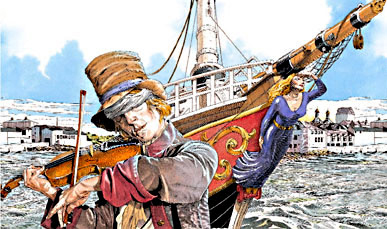
They
blessed my ship with soft flowing words of farewell. I gave her prow
to the sea and her stern to the land. The sails flapped against the
splintery masts.
I
drove on till
I REACHED HOME,
where those who loved me waited.
Songs
were sung and smooth drinks raised. Music in fiddle-strings to the
ever-healing of all ills, that would mend men's hearts and soothe women
in travail. With
the hero's fatigue I slept.
 |
|
|
|
The Legend of
the Sea Dragon

Legend has it that the
greatest Scottish warrior of all, Fionn mac Cumhaill – also known as
Fingal – was walking across Islay with his two massive hounds: Bran and
Seeolang.
Fionn, who was possessed
of supernatural powers and superhuman strength, hoisted a large standing
stone and threw it half-way across the island – into the depths of Loch
Indaal – for his dogs to fetch back. The splash made by the stone stirred
the dark sands at the bottom of the Loch, and with them stirred from his
thousand year sleep the sleeping form of the sea-dragon Kranna Dubh.
Kranna surged up from the
depths and swam to the shore at Bowmore to meet with Fionn in combat. A
fierce battle ensued, ending with Kranna lurching back into the loch,
mortally wounded by Fionn’s magical sword, Mac a’Luin, his dark blood
seeping into the waters.
It is said that when the
sun sets, Loch Indaal turns red with his blood – and that local mothers
scold their children severely, if ever they catch them pitching stones
into the Loch.
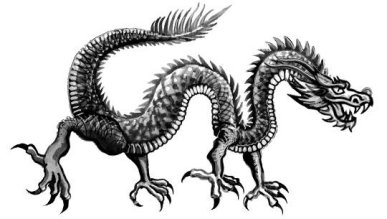 |
|
|
|
The Blacksmith
and the Fairies
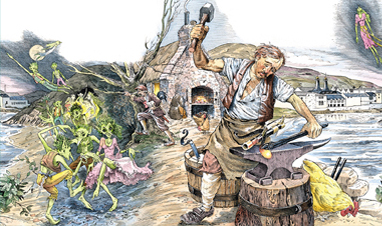
A long time ago – so the
legend goes – a blacksmith lived high on the Rhinns of Islay, with fine
views across Loch Indaal to Bowmore. His one son laboured
hard with him in his forge.
Suddenly, the son
fell ill. He lay on his bed, getting thinner, but eating more and more. No
one knew what was wrong. One day, an old man famous for his wisdom walked
into the forge, and over a dram of old Bowmore whisky, the smith told him
about his son.
‘It is not your son you
have got!’ the old man cried immediately. ‘Evil fairies have taken him to
the fairy hill, leaving a changeling - a fairy impostor - in his place!
But fear not, I’ll help you
rescue him!’
On the next full moon, he
said, the fairy hill would be open. He told the smith to approach on that
night, armed with a dagger and a cockerel that would crow loudly and
readily. The smith did so, and drew near the fairy hill in the moonlight.
He approached the entrance, and following the old man’s instructions,
thrust the dagger into it, to stop it closing on him. The fairies shrieked
when he entered, furious he had dared enter their realm. But he saw his
son labouring at the fairy forge and cried ‘I want my son and I will
not go without him!’
The fairies cackled loudly
at this, maddening the cockerel. It flapped its wings wildly and crowed
loud and long – incensing the fairies further. They seized the smith and
his son, threw them out of the hill and flung the dagger after them. The
hillside closed over. And from that day on, the smith and his son laboured
at their forge, creating wonderful weapons, the like of which had never
been seen beyond the fairy realm.
|
|
|
|
|
|
|
|
|
|
|
|
|
|
|
|
|
|
|
|
|
The Legend of
Godred Grovan

Goraidh Crobhan (pron:
Gorry Crow-van) was an Islay hero. According to the ancient stories,
he was the son of Harald the Black of Isla and his mother was a descendant
of the House of Erc, so he was popular with the people of both the Norse
and Celtic clans.
It seems
that, at one time, Islay was being attacked and harassed by a wild, fierce
dragon which had its den near Ballygrant, in the north of Islay. It was
said that, because the dragon had attacked almost all the islanders,
nothing could be seen on the island except the smoke rising from the three
single households that had been left unscathed.
Crobhan
– whose galley was anchored at the head of Lochindaal, near Bowmore –
heard the story and decided to take action.
He
galloped on horseback to the dragon’s den, taking with him three old
horses, which he placed at intervals along the route. He goaded the dragon
into coming out of his den and giving chase across the island. Crobhan
galloped on with the dragon at his heels. When the dragon came to the
first horse, he stopped, wolfed it down, then continued the chase. The
same thing happened with the other two horses. Each stop gave Goraidh
Crobhan time to keep ahead of the dragon.
By this
time, the dragon was so full of food that he became slow and sluggish in
his movements. From the shore to his ship, Crobhan had laid a line of
barrels from the distillery at Bowmore, on which he had hammered iron
stakes. Crobhan leaped across the barrels, but the old dragon, full and
moving laboriously, was impaled –leaving Crobhan to finish him off for the
people of Islay.
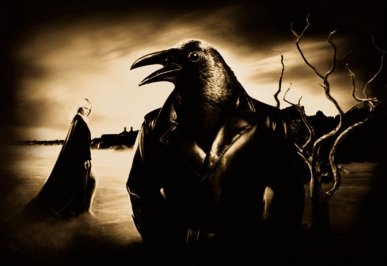 |
|
|
|
The Battle of
Gruinard

The Battle of Gruinard was a famous, ferocious Islay battle. The Clan
Maclean of Mull and the Macdonalds of Islay each claimed to be the
rightful owner of the Rhinns of Islay, the peninsula that lies across Loch
Indaal from the distillery at Bowmore.
Maclean decided to come to Islay to get the land back. Before leaving
Mull, Maclean consulted a wise woman. She gave him three warnings: never
land in Islay on a Thursday, never drink from Strange Neil's Well, and
never fight on the shores of Loch Gruinard.
‘Heed these,’
she said
‘and you
will leave Islay alive. Ignore these, and you will die from one single
blow!’
Maclean set off. He had planned to land on a Wednesday,
but because of terrible weather was delayed, and had to land on a
Thursday. Maclean has disregarded the first warning. On landing, Maclean
asked for a drink. He was given what was called
‘the
best water in Islay’.
Then, he was told it was from Strange Neil's Well. Too late, he remembered
the wise woman's warning! Nevertheless, Maclean persevered. He chose a
battle site and hoisted the Maclean flag. As the men gathered for battle,
he was told this was Gruinard - the very place the old woman had warned
him against.
Maclean had disregarded the woman's words of wisdom in
every respect. Despite this, Maclean carried on, preparing for battle.
Just before the battle began, a small, dark hunch-backed dwarf, called
Dubh Sith, came to Maclean to offer his services. Dubh Sith was
not only the son of a fairy mother, he was well known as an archer. But
Maclean scorned and mocked him. Furious, Dubh Sith sided with
Macdonald in the battle, with one aim: to kill Maclean. He hid in a rowan
tree waiting for Maclean, and then took careful aim with his bow, and
killed Maclean with one single arrow.
Maclean had disregarded the three warnings and was
dead; the Macdonalds won the Battle of Gruinard, thus regaining the Rhinns
of Islay.
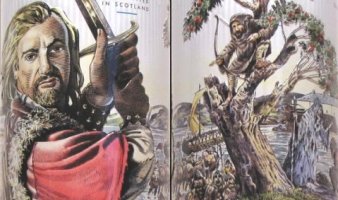
|
|
|
|
The Legend of
Donnachie Mhor
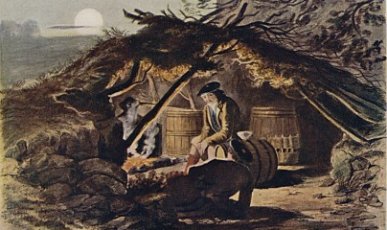
Legend has it, that long
ago in the village of Bowmore, on the Island of Islay, lived an illicit
distiller called Donnachie Mhor.
He was loved for his good
humoured pranks but loathed by the Customs man for his illegal whisky
production.
Donnachie's infamous
whisky still was old and leaking. Being a poor man he could not afford
to replace it but devised a cunning plan. He carried the old still to
the nearby peat moor, where it was buried and the spot marked with a
sheep's skull.
Some weeks later he met
the Customs man in the local Inn. In conversation, Donnachie explained
that he had turned over a new leaf and his days of illicit whisky making
were gone forever. The Customs man was pleased but suspicious, so to
prove his new character, Donnachie volunteered to take the Customs man
to where he knew an illegal still was hidden.
At midnight they set out
across the peat moor. After much searching they found a sheep's skull
and Donnachie suggested they start digging. As they dug through the soft
peat they struck the copper still.
The Customs man, delighted
with such a find, proudly carried the still back to Bowmore village
where he and Donnachie enjoyed a few drams of the Bowmore Malt in
celebration. Donnachie was given a handsome reward for reporting the
illegal still. The reward enabled Donnachie to purchase a brand new
larger illegal still!

|
|
|
|
| |
|
The Legend of St. Ives |
| |
 |
| |
|
Legend has it that in May
1813 during the Napoleonic Wars, a young French soldier - St. Ives - was
captured by his British enemies.
Spared execution due to
his knowledge of the English language, St. Ives was selected for special
employment and imprisoned in Edinburgh Castle. During his imprisonment,
St. Ives met and fell in love with a young visitor to the castle, Flora
Gilchrist.
Following his escape from
prison, he evaded recapture, ultimately making a daring escape from his
captors by hot air balloon. The balloon was carried westward by the east
winds, eventually crashing on Loch Indaal, upon whose shores stands
Bowmore Distillery.
St. Ives was rescued from
the icy waters by the True Blooded Yankee, a formidable American brig o'
war, that was holding Bowmore under siege. Later released to safety, St.
Ives was to be re-united with his beloved Flora. |
| |
 |
|

Updated
10-12-2018
 
back to top of page
|
